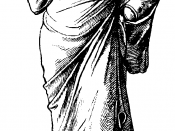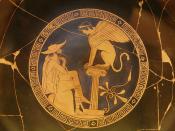Seeing All and Seeing None
In Sophocles' Oedipus Rex, sight and blindness are used as an underlying theme throughout the play. Sophocles makes the point that those with sight are not all seeing, and often those without sight see what others don't.
Our first encounter with blindness in the play comes when we are introduced to Tiresias, the blind prophet. Although Tiresias does not have the traditional use of sight, he is able to see what no one else does, the truth. Early in the play we learn how it came to be that Oedipus is King of Thebes. We are informed of the untimely death of his predecessor, Laius. The people of Thebes turn to Oedipus to solve the murder of their former king. Oedipus sends for Tiresias after being told that he has information regarding Laius' death. After an interrogation, Tiresias finally breaks down and tells Oedipus what he has been hiding.
That Oedipus himself is Laius' murderer. Oedipus, being furious with such accusations, taunts Tiresias, "You cannot hurt me, Nor any other who beholds the light, Your life being all one night." (Sophocles 14) Although Oedipus refuses to believe Tiresias' claims, the audience knows the truth. This is a strong example of how Sophocles uses sight, or lack of, to present the truth.
Oedipus was not the only one to hold sight, and still be blind to the truth. His wife Jocasta also suffered such ignorance. An oracle once told Jocasta and Laius that the son they would bear would kill his father and marry his mother. Appalled by such a prophecy, Jocasta silently had their son taken to the mountains and left for death. She was unaware that her son had survived and would inevitably live out his destiny. However Sophocles makes note...


